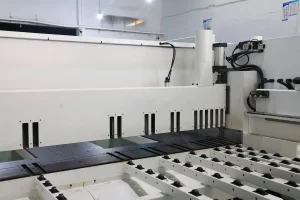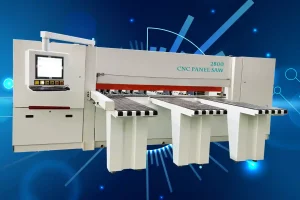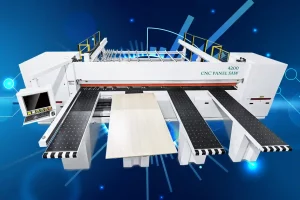
Troubleshooting Common Issues in CNC Panel Saw Operations: Ensuring Precision and Efficiency
The CNC panel saw is a sophisticated piece of equipment utilized in various industries to accurately cut panels of material to precise dimensions. While these machines offer remarkable precision and efficiency, they can occasionally encounter issues during operation. Understanding common problems and their potential solutions is vital to maximizing productivity and ensuring optimal performance. This article will delve into troubleshooting common issues in CNC panel saw operation.
Inconsistent Cutting Quality in CNC Panel Saw Operation
Inconsistent cutting quality is a prevalent issue faced by CNC panel saw operators. This problem can be attributed to several factors that affect the precision and finish of the cuts.
Introduction: Inconsistent cutting quality can significantly impact the efficiency and output of CNC panel saw operations. Loose or worn-out saw blades, incorrect blade selection, and inadequate pressure during cutting are common culprits.
One of the primary causes of inconsistent cutting quality is the condition of the saw blade. Over time, saw blades can become loose or worn out, resulting in jagged or burred edges on the cut material. Regular inspection and maintenance of the saw blades are crucial to ensuring clean cuts. Additionally, selecting the correct blade for the material type is essential. Using a blade designed for cutting wood on a plastic panel, for example, can lead to poor cutting quality.
Another factor that can affect cutting quality is the pressure applied to the material during cutting. If the material is not adequately clamped or supported, it can shift during the cutting process, leading to uneven cuts. Ensuring that the material is securely fastened and that the appropriate pressure is applied can help achieve consistent cutting quality.
Conclusion: Addressing issues related to saw blade condition, blade selection, and material pressure can significantly improve cutting quality. Regular maintenance and proper setup are key to maintaining the high precision expected in CNC panel saw operations.
Excessive Vibration in CNC Panel Saw Operation
Excessive vibration during CNC panel saw operation can not only affect the quality of the cuts but also cause damage to the machine itself. This section explores the common causes and solutions for vibration issues.
Introduction: Excessive vibration is a critical issue in CNC panel saw operations that can compromise both the machine and the quality of the cuts. Factors such as unbalanced or loose saw blades, inadequate material support, and incorrect machine settings often contribute to this problem.
One common cause of excessive vibration is an unbalanced or loose saw blade. Ensuring that the saw blade is properly balanced and securely fastened can reduce vibration significantly. Additionally, the support and clamping of the material are crucial. If the material is not adequately supported, it can move during cutting, causing vibrations.
Incorrect machine settings can also lead to excessive vibration. Settings such as feed rate, speed, and depth of cut need to be optimized for the material being processed. Using incorrect settings can put undue stress on the machine, leading to vibrations. Regularly checking and adjusting machine settings can help mitigate this issue.
Conclusion: To address excessive vibration, operators should focus on ensuring the saw blade is balanced and secure, providing adequate material support, and optimizing machine settings. These measures will help maintain smooth and efficient CNC panel saw operations.
Overheating Saw Blades in CNC Panel Saw Operation
Overheating of the saw blade is a common issue in CNC panel saw operations, particularly during continuous operation or when cutting through thick materials.
Introduction: Overheating saw blades can lead to reduced blade life and compromised cutting performance. Continuous operation, thick materials, and inadequate cooling are primary contributors to this issue.
Continuous operation of the CNC panel saw can generate excessive heat, especially when cutting thick or dense materials. This heat can cause the saw blade to overheat, leading to wear and tear and reducing the blade’s lifespan. To prevent overheating, it is essential to implement adequate cooling measures, such as using a coolant or ensuring proper airflow around the saw blade.
Regular blade changes are also important. Using a dull or worn-out blade can increase friction and heat generation during cutting. Ensuring that the blades are sharp and in good condition can help maintain optimal cutting performance and reduce the risk of overheating.
Conclusion: Preventing overheating requires regular blade changes and implementing adequate cooling measures. These steps will help maintain cutting performance and prolong the life of the saw blade in CNC panel saw operations.
Electrical Issues in CNC Panel Saw Operation
Electrical issues can arise during CNC panel saw operations, affecting the machine’s functionality and performance.
Introduction: Electrical issues are a significant concern in CNC panel saw operations. Power fluctuations and faulty electrical components can disrupt the machine’s operation, necessitating careful monitoring and maintenance.
Power fluctuations can cause the CNC panel saw to malfunction or stop working altogether. To address this, it is important to check and stabilize the power supply. Using a voltage regulator or an uninterruptible power supply (UPS) can help ensure a stable power supply and protect the machine from power-related issues.
Faulty electrical components can also lead to operational problems. Regular inspection of electrical connections and components can help identify and resolve issues before they cause significant disruptions. Replacing faulty components promptly is essential to maintaining the machine’s functionality.
Conclusion: Addressing electrical issues involves stabilizing the power supply and regularly inspecting electrical components. These measures help ensure continuous and efficient CNC panel saw operations.
Incorrect Programming or Machine Settings in CNC Panel Saw Operation
Incorrect programming or machine settings can lead to a range of issues in CNC panel saw operations, including inaccurate cuts and material damage.
Introduction: Programming and machine settings are critical to the success of CNC panel saw operations. Improperly defined toolpaths, feed, and speed settings can cause operational problems and affect the quality of the cuts.
Toolpaths define the movement of the saw blade during cutting. Incorrectly defined toolpaths can result in inaccurate cuts or even damage the material being processed. Ensuring that toolpaths are correctly programmed and validated before operation is essential to achieving precise cuts.
Feed and speed settings also play a crucial role in CNC panel saw operations. Incorrect settings can lead to poor cutting performance and damage the material. Reviewing and optimizing these settings based on the material type and thickness can help achieve better results.
Conclusion: To prevent issues related to programming and machine settings, operators should thoroughly review and validate toolpaths, feed, and speed settings. Proper programming ensures accurate cuts and efficient CNC panel saw operations.
Inadequate Lubrication in CNC Panel Saw Operation
Inadequate lubrication can lead to operational problems in CNC panel saw operations, affecting the machine’s efficiency and lifespan.
Introduction: Proper lubrication of moving parts is essential for smooth and efficient CNC panel saw operations. Inadequate lubrication can cause increased friction, wear and tear, and ultimately lead to machine failure.
Regular lubrication schedules should be established and followed to ensure that all moving parts operate smoothly. Using the appropriate lubricants for different components is also important to prevent wear and maintain the machine’s efficiency.
Lubrication not only reduces friction but also helps in cooling the components, preventing overheating. Ensuring that the machine is adequately lubricated can prolong its lifespan and enhance its performance.
Conclusion: Establishing regular lubrication schedules and using appropriate lubricants are crucial for maintaining smooth and efficient CNC panel saw operations. Proper lubrication reduces friction and wear, contributing to the machine’s longevity and performance.
Troubleshooting common issues in CNC panel saw operation involves addressing factors that affect cutting quality, reducing excessive vibration, preventing saw blade overheating, resolving electrical issues, ensuring correct programming and machine settings, and maintaining adequate lubrication. By understanding and addressing these common problems, operators can enhance the precision and efficiency of CNC panel saw operations, leading to improved productivity and optimal performance.
FAQ
Q: Why is inconsistent cutting quality a common issue in CNC panel saw operations? A: Inconsistent cutting quality can be caused by loose or worn-out saw blades, incorrect blade selection, and inadequate pressure applied to the material during cutting. Regular maintenance and proper setup can address these issues.
Q: What causes excessive vibration during CNC panel saw operation? A: Excessive vibration can result from unbalanced or loose saw blades, inadequate support or clamping of the material, and incorrect machine settings. Ensuring balanced blades, proper material support, and optimized settings can reduce vibrations.
Q: How can overheating of the saw blade be prevented in CNC panel saw operations? A: Overheating can be prevented by implementing adequate cooling measures, such as using coolants and ensuring proper airflow around the saw blade, as well as regularly changing dull or worn-out blades.
Q: What are common electrical issues in CNC panel saw operations and how can they be resolved? A: Common electrical issues include power fluctuations and faulty electrical components. Stabilizing the power supply with a voltage regulator or UPS and regularly inspecting and replacing faulty components can resolve these issues.
Q: How do incorrect programming and machine settings affect CNC panel saw operations? A: Incorrect programming and machine settings can lead to inaccurate cuts and material damage. Thoroughly reviewing and validating toolpaths, feed, and speed settings before operation can prevent these issues.
Q: Why is lubrication important in CNC panel saw operations? A: Proper lubrication reduces friction and wear on moving parts, preventing operational problems and extending the machine’s lifespan. Regular lubrication schedules and the use of appropriate lubricants are essential for maintaining efficiency.
Q: How often should maintenance be performed on CNC panel saws to prevent common issues? A: Regular maintenance should be performed daily for cleaning and inspection, weekly for lubrication, and monthly or quarterly for comprehensive checks of all components to ensure optimal performance and prevent common issues.
Q: What role does operator training play in preventing issues in CNC panel saw operations? A: Operator training is crucial for understanding proper machine setup, maintenance procedures, and troubleshooting techniques. Well-trained operators can effectively prevent and resolve common issues, ensuring smooth and efficient CNC panel saw operations.
Q: Can software updates help in troubleshooting CNC panel saw issues? A: Yes, software updates can provide improved functionality, fix bugs, and enhance the machine’s performance. Keeping the CNC panel saw software up to date can help prevent and resolve operational issues.





































